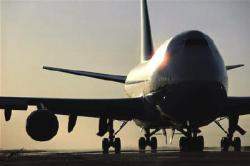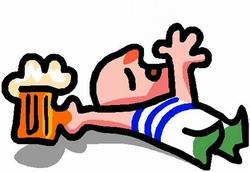Tue, Feb 04, 2003
 According to 2002 statistics compiled by Medaire, airlines had
their hands full in managing passenger medical-related issues.
Statistics show that during the year, flight crews of 40 airlines
called on-the-ground physicians more than 8,400 times for
assistance in dealing with inflight medical incidents and
emergencies -- the most common of which was people fainting.
According to 2002 statistics compiled by Medaire, airlines had
their hands full in managing passenger medical-related issues.
Statistics show that during the year, flight crews of 40 airlines
called on-the-ground physicians more than 8,400 times for
assistance in dealing with inflight medical incidents and
emergencies -- the most common of which was people fainting.
The statistics are based on the inflight medical incidents and
emergencies onboard airlines that utilize the services of MedAire
-- a company that provides airlines with 24/7 inflight access to
hospital-based emergency room physicians. More than 65 percent of
all inflight medical emergencies fell under one of just five
different types of events:
- Vasovagal (i.e. fainting)
21.5%
-
Gastrointestinal
15.4%
-
Respiratory
10.2%
-
Cardiac
9.6%
-
Neurological
8.7%
 MedAire's president and CEO, Joan Sullivan
Garrett, attributes the overall rise of inflight medical incidents
to the increasing average age of travelers, stress and because more
sick passengers are attempting to fly. "Often times travelers will
attempt trips with complete disregard for any medical conditions
they might already have. The declining flexibility in being able to
make changes to travel plans due to change fees and/or the
prospects of forfeiting the cost of a ticket may also be
influencing people's willingness to risk flying when they really
shouldn't."
MedAire's president and CEO, Joan Sullivan
Garrett, attributes the overall rise of inflight medical incidents
to the increasing average age of travelers, stress and because more
sick passengers are attempting to fly. "Often times travelers will
attempt trips with complete disregard for any medical conditions
they might already have. The declining flexibility in being able to
make changes to travel plans due to change fees and/or the
prospects of forfeiting the cost of a ticket may also be
influencing people's willingness to risk flying when they really
shouldn't."
 Dr.
David Streitwieser, medical director at MedAire's MedLink Global
Response Center -- a 24/7 communications center that managed these
remote medical emergencies, says that it's no surprise that
vasovagal episodes remain the top medical category. "We are helping
cabin crew manage these situations everyday," says Streitwieser. "A
common scenario occurs when a passenger has been sitting
comfortably for several hours then gets up suddenly to use the
lavatory. The passenger becomes very pale and dizzy and then
collapses to the floor in an apparent faint. When managing the
situation, it's important to stay calm, remember your ABCs and
check the passenger to make sure he or she is still breathing and
has a pulse."
Dr.
David Streitwieser, medical director at MedAire's MedLink Global
Response Center -- a 24/7 communications center that managed these
remote medical emergencies, says that it's no surprise that
vasovagal episodes remain the top medical category. "We are helping
cabin crew manage these situations everyday," says Streitwieser. "A
common scenario occurs when a passenger has been sitting
comfortably for several hours then gets up suddenly to use the
lavatory. The passenger becomes very pale and dizzy and then
collapses to the floor in an apparent faint. When managing the
situation, it's important to stay calm, remember your ABCs and
check the passenger to make sure he or she is still breathing and
has a pulse."
Vasovagal episodes often happen suddenly and appear to occur
more frequently at high altitude. A variety of stimuli can cause
vasovagal reactions including nausea, pain, fear and anxiety,
urinary urgency, abdominal discomfort and motion sickness. Standing
up will accelerate the drop in blood pressure that occurs during
these reactions and exacerbates the dizziness and weakness.
More News
Light Gun A handheld directional light signaling device which emits a brilliant narrow beam of white, green, or red light as selected by the tower controller. The color and type of>[...]
“We have performed extensive ground testing by comparing warm up times, full power tethered pulls, and overall temperatures in 100 degree environments against other aircraft >[...]
While Taxiing To Parking The Right Landing Gear Leg Collapsed, Resulting In Substantial Damage Analysis: The pilot made a normal approach with full flaps and landed on the runway. >[...]
From 2014 (YouTube Edition): Exotic Rebuild Reveals Aerial Work Of Art During EAA AirVenture 2014, ANN's Michael Maya Charles took the time to get a history lesson about a great ai>[...]
Also: Project Talon, McFarlane Acquisition, Sky-Tec Service, JPL Earth Helo Tests Bombardier has earned a round of applause from the business aviation community, celebrating the fo>[...]
 ANN's Daily Aero-Term (12.13.25): Light Gun
ANN's Daily Aero-Term (12.13.25): Light Gun Aero-News: Quote of the Day (12.13.25)
Aero-News: Quote of the Day (12.13.25) NTSB Final Report: Gippsland GA-8
NTSB Final Report: Gippsland GA-8 Classic Aero-TV: Historically Unique -- Marlin Horst's Exquisite Fairchild 71
Classic Aero-TV: Historically Unique -- Marlin Horst's Exquisite Fairchild 71 Airborne 12.12.25: Global 8000, Korea Pilot Honors, AV-30 Update
Airborne 12.12.25: Global 8000, Korea Pilot Honors, AV-30 Update





